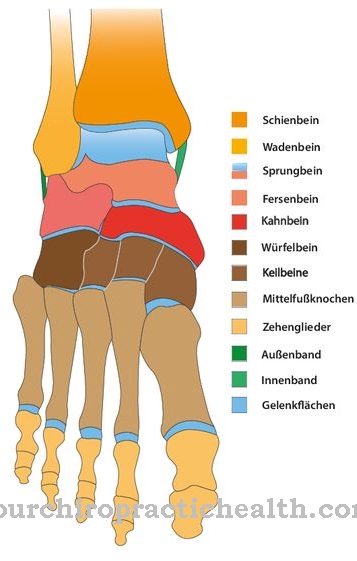In the Cat scratch diseasecaused by bacteria, the pathogen enters the human organism mainly through scratches in cats. The cats themselves either don't get sick at all or only slightly.
What is cat scratch disease?

© tpap8228 - stock.adobe.com In the Cat scratch disease it is a common infectious disease in which the local lymph nodes are inflamed. Fever, limb pain and headaches can also occur. The cat-scratch disease, which is transmitted from infected cats to humans through scratches or bite wounds, is usually harmless. The pathogens include bacteria Bartonella henselae and Bartonella clarridgeiae.
It is assumed that the cat can also become infected through the flea infestation, although the assumption has not been proven. According to research, around every tenth cat carries the bacteria. The disease is not transmitted from person to person, only from cat to person. Above all, people with a weakened immune system are more often affected by cat scratch disease.
causes
In principle, the cat scratch disease can affect anyone, but cat owners are particularly at risk due to the transmission path. Since young animals in particular are contagious, cat scratch disease is more common in households with very young cats, but the disease can also be transmitted by older animals. Most people affected by cat disease are up to 21 years old or still young.
The reason for this is that children often have close contact with the pet and, on the other hand, do not yet have a fully developed immune system. But adult people with a weakened immune system are also more likely to develop cat scratch disease. They also often show a more severe course. The pathogen reaches the claws of a cat in various ways: When the animal licks its paws, the bacteria contained in the saliva and blood reach the claws.
Another possibility is when fleas settle in and suckle the cat's blood. They are excreted with the excrement of the fleas and are located in the fur. Since the puncture site itches, the cat scratches itself and the feces of the fleas get under its claws. If the cat licks an area of the human skin that has previously been scratched or previously damaged, the pathogen can be transmitted. Since the flea also bites people, direct transmission is also possible, although this is far less the case.
Symptoms, ailments & signs
The initial symptoms of cat scratch disease can show up in as little as two to three days, but it is also possible that this can take two months. Therefore, the cat bite is often no longer suspected as a trigger after such a long time. Symptoms may include scratching or bite marks on the cat, even if they may have healed.
Red pustules or papules in the area of the wound as well as swollen and inflamed, sometimes painful lymph nodes in the armpits or neck are also signs of an illness. Possible side effects can be flu-like symptoms such as fever, headache, pain in the limbs, throat and stomach, chills, nausea and vomiting.
In poor health or a weakened immune system, for example in the context of an HIV infection or AIDS, the normally harmless cat scratch disease can result in blood poisoning, meningitis or heart valve inflammation. Caution is therefore advisable for people with poor health or underlying illnesses.
Diagnosis & course of disease
Since the symptoms of cat scratch disease are often very different and can also occur with other diseases, the doctor needs to know how the disease is developing. Of course, the question of whether there are cats in the household is also crucial. A blood test is also carried out. When the body comes into contact with the pathogen, it forms specific antibodies against the bacterium, which can be detected in the blood.
The pathogen can also be cultured using a blood sample, which takes a few weeks. A clear result is then possible. If the diagnosis is difficult, tissue can also be removed from a swollen lymph node in order to reliably determine the disease. Cat scratch disease is usually harmless.
Complications rarely occur when the bacteria attack the heart, bones or lungs, for example, and cause inflammation. If the pathogens multiply too much in the blood, this can lead to blood poisoning and anemia, which is life-threatening and must be treated in a hospital intensive care unit.
Complications
In most cases, cat scratch disease is diagnosed very late. This disease can take a few months to show the first symptoms, so in most cases treatment is delayed. As a rule, those affected primarily suffer from pain caused by the cat's bite or scratching.
Papules and pustules form on the body. The affected regions can swell and become painful. It is not uncommon for those affected to continue to suffer from a fever and fatigue. Symptoms similar to those of common flu also appear. In the worst case, however, blood poisoning occurs and thus inflammation of the heart or brain. The patients also suffer from nausea, vomiting and chills.
The everyday life of the person concerned is restricted and there is a reduction in resilience. The treatment of cat scratch disease is done with the help of antibiotics. There are no further complications. However, these can occur if the patient already suffers from a weakened immune system. Life expectancy can also be reduced if necessary.
When should you go to the doctor?
If people who are in direct contact with cats show changes in their health, they should consult a doctor. A doctor is needed in the event of sudden changes in the appearance of the skin such as redness and the formation of poplars or pustules. If the first abnormalities appear a few days after contact with cats, a doctor's visit is also necessary. If pain occurs, if there is a fever or an increased body temperature and swelling of the body, a doctor should be consulted.
If lymph nodes in the neck or armpits increase in size and tenderness, this is considered an indication of the disease and should be investigated. In the case of flu-like symptoms such as repeated vomiting, nausea or dizziness, a medical examination is necessary to clarify the cause. Chills, abdominal pain, digestive problems, limb discomfort, sore bones or head should be presented to a doctor.
If existing symptoms spread or if they intensify, a doctor's visit is required. Fatigue, tiredness, a decrease in normal performance and a feeling of illness must be assessed by a doctor. In the case of cat scratch disease, symptoms often arise after a bite or scratch wound on the skin. In addition to the signs described, a visit to the doctor is necessary in the event of poor wound healing.
Treatment & Therapy
Since the cat scratch disease is a bacterial infection, it can be treated well with an antibiotic if it is complicated or severe. This is usually taken for four weeks. If the illness is accompanied by flu-like symptoms, antipyretic medication or pain relievers can also be prescribed.
For people with a strong immune system and without a history of illness, however, no medication is usually necessary because the symptoms occur only slightly in these people and go away on their own.
You can find your medication here
➔ Medicines against swelling of the lymph nodesOutlook & forecast
Healthy adults usually only experience mild flu-like symptoms in the form of headache, aching limbs or a slight fever, which do not require medical treatment. Those affected primarily suspect the presence of a mild flu-like infection and avoid visiting a doctor. You use warm baths, cold compresses, ginger tea or rubbing with rubbing alcohol as home remedies to alleviate the symptoms. An intact immune system can usually fight an infection with the bacterial pathogens that cause cat scratch disease itself.
A health care professional must always be contacted if the fever rises or existing symptoms worsen. Likewise with a locally occurring, inflammatory reaction after a scratch or bite injury by a cat.
In the elderly, children or chronically ill people, however, the immune system is not fully functional and usually not able to fight the infection itself. In order not to lose time, it is necessary to immediately consult a doctor and start drug treatment.
Especially with children, it is important to teach them certain rules of conduct for dealing with cats in order to prevent a new disease. If you have open wounds, you should stay away from the cat with a plaster until the first aid and never let the cat lick the wound.
prevention
Prevention is to always clean and disinfect the wounds well after being injured by cats. After contact, it is recommended to wash your hands thoroughly with soap and water. The cats should also be reliably freed from fleas on a regular basis. Vaccination is currently not available. In the case of an acute underlying disease, it can make sense to give up the cat temporarily if possible.
Aftercare
The cat scratch disease is treated acutely. Scheduled follow-up examinations are not found in everyday practice. After a single illness, the attending physician will advise you on preventive measures to prevent the recurrence of typical symptoms. However, the patient bears responsibility for this. Flea control in cats is of fundamental importance. Adequate hygiene after contact with pets is also imperative.
Cat scratch disease has complications in certain people. The risk group includes people with a weakened immune system. In the worst case scenario, life-threatening blood poisoning occurs. Affected patients should avoid contact with pets completely because of the danger. However, this is not checked by the attending physician. He communicates this after an initial diagnosis. The patient is responsible for the implementation.
There is no reason for long-term treatment, which can be part of the aftercare. Usually there is spontaneous healing. However, the patient can be infected again at any time. A blood analysis allows a clear diagnosis. In the longer term, an antibiotic promises rapid relief. Pet owners must consistently adhere to the preventive measures described. This reduces the risk of infection. The instruction regarding suitable preventive measures in everyday life replaces a scheduled follow-up examination.
You can do that yourself
Cat disease is a bacterial infection that has symptoms not unlike those of mild flu. In healthy adults with an intact immune system, medical treatment is usually not required. Most of the time, those affected are not even aware that they didn't just catch a cold. Even those who have been injured by a cat and are afraid of being infected with the cat disease can first of all wait and see. Less severe side effects such as headache and body aches or a slight fever can also be treated with over-the-counter drugs without hesitation. However, a doctor should always be consulted if the symptoms worsen, especially if a high fever sets in or the scratch or bite wound becomes infected.
Caution is also advised in children and senior citizens, as the immune system of these groups of people is not yet or no longer fully functional. If a cat lives in the house and these people show signs of the cat's disease, self-help measures should not be experimented with, but a doctor should be sought immediately. The same applies to people whose immune system is weakened due to an illness.
The pathogens are also found in the cat's saliva. To reduce the risk of infection, children should learn that they can get sick if they allow the pet to lick open knees or other small injuries.

.jpg)

.jpg)




















.jpg)



